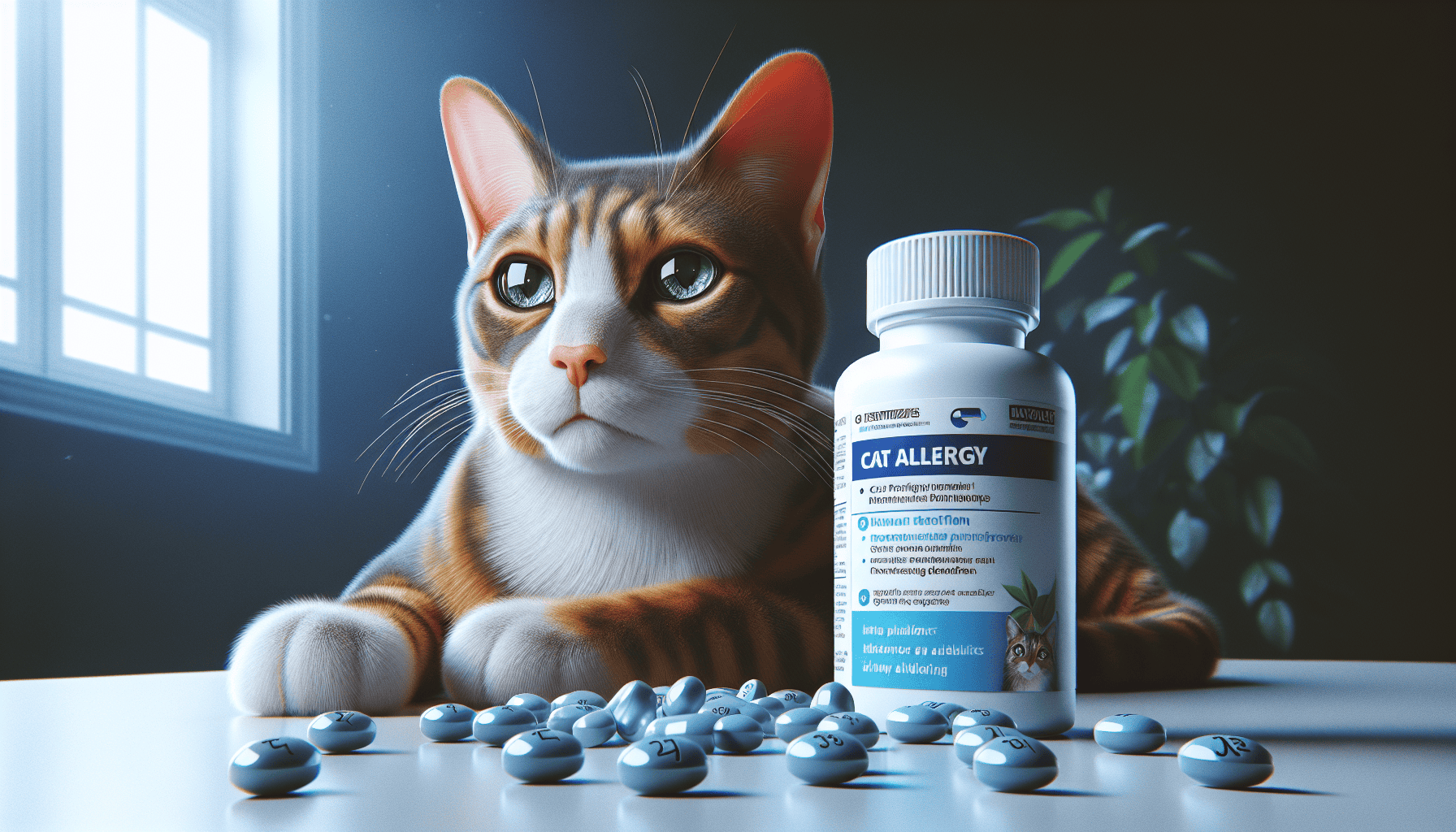Understanding Cat Allergies
Cat allergies can be a common concern for many individuals, particularly those who are cat owners or spend time in environments where cats are present. In this section, we will delve into the prevalence of cat allergies and the causes behind them.
Prevalence of Cat Allergies
Nearly a third of Americans with allergies are allergic to cats and dogs, with cat allergies being more prevalent than dog allergies (Healthline). In fact, cat allergies affect twice as many people as dog allergies. It is estimated that about 10% of the U.S. population has pet allergies, with cats being among the most common culprits. It’s important to note that individuals with cat allergies are actually allergic to proteins found in the cat’s saliva, urine, and dander, rather than the fur or hair itself.
While there are some cat breeds that are considered “hypoallergenic,” it’s crucial to understand that any cat has the potential to cause allergy issues. Even breeds with less hair, minimal shedding, or specific coat characteristics can still trigger allergies. If you or a family member is allergic to cats, it may be necessary to reconsider getting a cat, regardless of breed or hair length (WebMD). If keeping a cat poses health risks, it may be advisable to explore other options.
Causes of Cat Allergies
The development of cat allergies can be influenced by various factors, including genetics and exposure to cats. Genetics play a role in the susceptibility to allergies, meaning that individuals with family members who have allergies are more likely to experience allergies themselves (Healthline).
When individuals with cat allergies come into contact with cat allergens, their immune system reacts by producing antibodies to fight off what it perceives as a threat. The allergens that trigger these immune responses are primarily found in the cat’s saliva, urine, and dander. When cats groom themselves, the allergens from their saliva are transferred to their fur, which can then become airborne or deposited on surfaces. As a result, individuals with cat allergies may experience symptoms when they come into contact with cats or areas where cats have been present.
Understanding the prevalence and causes of cat allergies is crucial for individuals who experience these allergies or are at risk of developing them. By gaining knowledge about cat allergies, individuals can be better equipped to manage their symptoms and make informed decisions about their interactions with cats. To explore treatment options for cat allergies, refer to the section on medications for cat allergies and allergy shots and immunotherapy.
Symptoms and Reactions
When it comes to cat allergies, understanding the symptoms and reactions is essential for effective management and treatment. Cat allergies can manifest in a range of symptoms, from mild to severe. It’s important to recognize these symptoms and seek appropriate care to alleviate discomfort and prevent complications.
Common Cat Allergy Symptoms
Cat allergy symptoms can vary from person to person, but some common signs to watch out for include:
- Itching: Itchy, red, and watery eyes, as well as itchiness on the skin, are common symptoms of cat allergies.
- Nasal Congestion: Runny or stuffy nose, sneezing, and post-nasal drip are often experienced by individuals with cat allergies.
- Respiratory Issues: Asthma symptoms such as wheezing, coughing, and shortness of breath may be triggered by exposure to cat allergens.
- Skin Reactions: Some individuals may experience skin reactions like redness, rash, or hives upon contact with cat allergens.
These symptoms can affect individuals differently, and the severity may vary from person to person. It’s important to note that symptoms can sometimes turn serious, with about 20% to 30% of people with allergic asthma experiencing severe flare-ups after coming in contact with a cat (WebMD). If you experience wheezing, difficulty breathing, trouble sleeping, or shortness of breath, it is advisable to seek medical help promptly.
Severe Cat Allergy Reactions
In severe cases, cat allergies can lead to acute asthma attacks or anaphylaxis, a severe and potentially life-threatening allergic reaction. Symptoms of severe cat allergies may include:
- Acute Asthma Attacks: Exposure to cat allergens can trigger sudden and severe asthma symptoms like difficulty breathing, chest tightness, and wheezing.
- Anaphylaxis: Although rare, some individuals may experience a severe allergic reaction called anaphylaxis. Symptoms can include swelling of the face, lips, or throat, difficulty breathing, rapid heartbeat, and a drop in blood pressure. Anaphylaxis requires immediate medical attention.
If you or someone you know experiences severe cat allergy reactions, it is crucial to seek emergency medical care. An allergist or immunologist can provide guidance on appropriate treatment options to manage severe cat allergies effectively.
By recognizing the symptoms and reactions associated with cat allergies, individuals can take appropriate measures to minimize exposure to cat allergens and seek the necessary treatment. If you suspect that you or a loved one has cat allergies, consult with a healthcare professional or allergist for proper diagnosis and guidance on managing cat allergies. Remember, the goal is to find relief and create a safe environment for both you and your feline companion.
Treatment Options
When it comes to managing cat allergies, there are several treatment options available. These options can help alleviate symptoms and improve the quality of life for individuals who are allergic to cats. The treatment options include avoidance and management strategies, medications, and allergy shots or immunotherapy.
Avoidance and Management Strategies
One of the primary approaches to managing cat allergies is to minimize exposure to cat allergens. While complete avoidance may not always be possible, there are steps you can take to reduce your exposure and alleviate symptoms. Some avoidance and management strategies include:
- Designating “cat-free” areas in the home, such as bedrooms, to create allergen-free zones.
- Using high-efficiency particulate air (HEPA) filters to trap cat allergens in the air.
- Regularly cleaning and vacuuming your home to remove allergens from surfaces.
- Washing hands thoroughly after coming into contact with cats.
- Considering hypoallergenic cat breeds, which produce fewer allergens.
By implementing these strategies, you can minimize your exposure to cat allergens and reduce the severity of your symptoms.
Medications for Cat Allergies
Medications can help alleviate symptoms and manage cat allergies. Over-the-counter antihistamines such as Benadryl, Claritin, and Flonase can provide temporary relief from symptoms like sneezing, itching, and nasal congestion. These medications work by blocking the effects of histamine, a chemical released by the immune system during an allergic reaction.
It’s important to note that these medications may cause drowsiness in some individuals, so it’s advisable to read and follow the instructions and consult with a healthcare professional if needed. Additionally, there are prescription medications available that can provide more targeted relief for specific symptoms. These medications may include montelukast, which works by blocking chemicals that trigger allergic reactions.
Allergy Shots and Immunotherapy
For individuals with severe cat allergies or those who do not find relief from other treatment options, allergy shots, also known as immunotherapy, can be considered. Allergy shots involve a series of injections containing small amounts of cat allergens. The goal is to gradually desensitize your immune system to the allergens over time, reducing the severity of your allergic reaction.
Allergy shots are typically administered over a period of several months to years and are tailored to the individual’s specific allergies. It’s important to note that allergy shots may not be suitable for everyone, and the decision to pursue this treatment option should be made in consultation with an allergist or immunologist.
Immunotherapy can be an effective long-term solution, as it can reduce or eliminate the need for other medications. However, it requires commitment and patience, as the treatment process can take time to be fully effective.
By exploring these treatment options and working closely with a healthcare professional, you can find the right approach to manage your cat allergies and find relief from your symptoms. Remember, each individual’s response to treatment may vary, so it’s essential to find the approach that works best for you.
Home Remedies and Care
When it comes to managing cat allergies, there are some home remedies and care techniques that can provide relief from symptoms. These remedies can be used alongside other cat allergy treatments to help minimize discomfort. In this section, we will explore nasal irrigation for allergy relief and offer tips for dealing with cat allergies at home.
Nasal Irrigation for Allergy Relief
Nasal irrigation is a technique that involves flushing out the sinuses with a saline solution to clear out thick mucus and irritants. This can be done using a neti pot or a squeeze bottle with a saline rinse. The saline solution helps to moisturize the nasal passages and reduce inflammation, providing temporary relief from congestion and other nasal allergy symptoms.
To perform nasal irrigation, follow these steps:
- Prepare a saline solution by mixing clean water and salt. It is important to use clean water to avoid introducing any additional irritants.
- Fill the neti pot or squeeze bottle with the saline solution.
- Lean over a sink and tilt your head to one side.
- Gently insert the spout of the neti pot or squeeze bottle into one nostril, allowing the saline solution to flow through the nasal passage and out of the other nostril.
- Repeat on the other side, tilting your head in the opposite direction.
It is crucial to use the correct technique and sterile equipment to avoid any complications. Remember to rinse the neti pot or squeeze bottle thoroughly with clean water after each use to maintain hygiene (WebMD).
Dealing with Cat Allergies at Home
In addition to nasal irrigation, there are several other steps you can take to manage cat allergies at home:
- Keep the cat out of your bedroom: Designate your bedroom as a pet-free zone to minimize exposure to allergens while you sleep.
- Use allergen-proof bedding: Invest in allergen-proof mattress and pillow covers to create a barrier against allergens like cat dander.
- Vacuum and dust regularly: Use a vacuum cleaner with a HEPA filter to effectively remove allergens from carpets, upholstery, and other surfaces. Dusting with a damp cloth can also help trap allergens.
- Wash bedding frequently: Wash your bedding, including sheets, pillowcases, and blankets, in hot water to eliminate allergens.
- Consider air purifiers: High-efficiency particulate air (HEPA) filters can help capture allergens from the air, reducing their presence in your home.
- Bathe your cat: Regular bathing of your cat can help reduce the amount of allergens present in their fur. Consult your veterinarian for guidance on cat bathing techniques and products.
While these home remedies and care practices can provide relief, it is important to note that they may not completely eliminate cat allergies. If your symptoms persist or worsen, it is advisable to consult with a healthcare professional for further guidance and cat allergy medication options.
Remember, each person’s response to cat allergies may vary, so it’s essential to find a management strategy that works best for you. By incorporating these home remedies and care practices into your routine, you can create a more comfortable living environment while enjoying the companionship of your feline friend.
Allergy Medications for Cats
When it comes to managing cat allergies, there are various medications available to provide relief for your feline companion. These medications can help alleviate the symptoms associated with cat allergies and improve your cat’s overall comfort. In this section, we will explore two types of allergy medications for cats: prescription medications and over-the-counter options.
Prescription Medications for Cats
Prescription medications for cat allergies are typically recommended and prescribed by a licensed veterinarian. These medications are specifically formulated to target the underlying causes of allergic reactions in cats. Some commonly prescribed medications for cat allergies include:
| Medication | Description |
|---|---|
| Atopica | Helps control allergic skin disease in cats by suppressing the immune response. |
| Prednisone | A corticosteroid that reduces inflammation and suppresses the immune system. |
| Hydroxyzine HCL | An antihistamine that blocks the effects of histamine, a substance released during an allergic reaction. |
| Pentoxifylline | Helps improve blood flow and reduce inflammation in cats with allergic skin conditions. |
| Cyproheptadine HCl | An antihistamine that helps relieve itching caused by allergies. |
These medications are typically obtained through a veterinary prescription. You can place prescription orders for cat allergy medication through the PetSmart Pharmacy website, provided you have an active prescription prescribed by a vet within the last 12 months. All medications are fulfilled by Allivet, a trusted provider of pet medications.
Over-the-Counter Options for Cats
In addition to prescription medications, there are also over-the-counter (OTC) options available for managing cat allergies. These medications can be purchased without a prescription and are generally safe for use in cats. OTC allergy medications for cats may include:
| Medication | Description |
|---|---|
| Antihistamines | Over-the-counter antihistamines such as chlorpheniramine and diphenhydramine can help alleviate itching and sneezing caused by allergies. However, it’s important to consult with your veterinarian before administering any OTC medications to your cat. Dosage and safety considerations may vary based on your cat’s individual needs. |
Always consult with your veterinarian before giving any medication, including OTC options, to your cat. Your veterinarian can provide guidance on the appropriate dosage and recommend the most suitable medication for your cat’s specific allergy symptoms.
It’s important to remember that while medications can provide relief, they may not address the underlying cause of the allergy. Allergy medications are typically used in conjunction with other management strategies, such as minimizing exposure to allergens and creating an allergen-free environment for your cat. For more information on managing cat allergies, refer to our section on cat allergies treatment.
By working closely with your veterinarian and exploring the available allergy medications, you can find the most effective solution to alleviate your cat’s allergy symptoms and improve their quality of life.
Considerations and Precautions
When it comes to managing cat allergies and exploring the use of allergy medications, there are important considerations and precautions to keep in mind. It is essential to understand the potential side effects of allergy medications and take necessary steps to effectively manage cat allergies.
Side Effects of Allergy Medications
Allergy medications can provide relief from cat allergy symptoms, but it’s important to be aware of the potential side effects associated with certain medications. Here are some common side effects to consider:
-
Topical Corticosteroids: Topical corticosteroids, such as creams or ointments, may cause thinning of the skin and mucous membranes, skin discoloration, and skin irritation with long-term use (News-Medical).
-
Oral Corticosteroids: Oral corticosteroids, often prescribed for severe allergic reactions, may lead to severe side effects with long-term use, including osteoporosis, diabetes, hypertension, and cataracts (News-Medical).
-
Leukotriene Inhibitors: Leukotriene inhibitors, taken orally, are associated with psychological side effects such as irritability, anxiety, hallucinations, aggressive behavior, depression, suicidal ideation or behavior, and insomnia (News-Medical).
-
Allergen Immunotherapy: Allergen immunotherapy, including subcutaneous and sublingual methods, is used to induce immune tolerance and potentially provide a permanent cure for allergies like hay fever. However, the chronic side effects of this therapy are currently unknown (News-Medical).
Tips for Managing Cat Allergies
In addition to considering the potential side effects of allergy medications, there are several tips and precautions you can take to effectively manage cat allergies:
-
Create Allergy-Free Spaces: Designate certain areas of your home as “allergy-free zones” where your cat is not allowed. This can help reduce exposure to allergens in your living space.
-
Regular Cleaning: Regularly clean your home, including vacuuming carpets and furniture, to remove cat dander and allergens. Consider using a HEPA filter in your vacuum cleaner and air purifiers to improve air quality.
-
Wash Hands and Clothing: Wash your hands thoroughly after petting or handling your cat. Additionally, change and wash your clothes after interacting with your cat to minimize exposure to allergens.
-
Consider Hypoallergenic Cats: If you are considering getting a new cat, research hypoallergenic cat breeds that produce fewer allergens and may be more suitable for individuals with allergies.
-
Consult with a Healthcare Professional: If your cat allergies are severe or affecting your quality of life, consult with a healthcare professional or allergist. They can provide guidance on appropriate allergy medications and other treatment options tailored to your specific needs.
When it comes to managing cat allergies, it’s important to find the right balance between effective symptom relief and minimizing potential side effects. By taking precautions and following these tips, you can create a more comfortable environment for yourself while enjoying the companionship of your furry friend. For more information on cat allergies and related topics, consider exploring our articles on cat allergy relief, cat allergy shots, and cat allergy testing.







